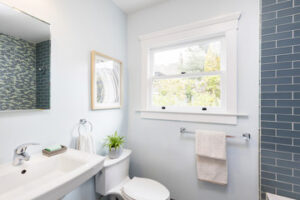Small windows can be a challenge, but the right blinds can maximize light and space. They can also be energy-saving by trapping air between slats and blocking out sunlight in the summer.

Accurate measurements are essential to achieving an attractive and functional window treatment. This is especially true with inside mount blinds that promise a sleek integration within the window frame. Keep reading the article below to learn more about Small Window Blinds.
Roller shades are a sleek, stylish window treatment that offers excellent light control and privacy. They’re also great for rooms with a view, as they can be easily rolled up to enjoy the scenery.
Roller shade fabrics come in a wide range of colors and textures, and the level of privacy you desire can be achieved by selecting either sheer or opaque fabric. The type of fabric you select is important for both aesthetics and energy efficiency, as different materials provide different insulation levels.
When it comes to color, bright shades are a trending option for windows and offer a pop of personality. When selecting a bright shade, make sure the color coordinates with your room’s decor and doesn’t overwhelm it. If you want a more subtle look, consider a dark or neutral shade for your home.
If you’re in the market for a more modern style, grey roller shades are an easy and stylish choice. Whether you prefer the moody vibes of charcoal, cozy comfort of heather, or airy feel of greige, grey shades can add a timeless elegance to any room.
To keep your blinds simple and safe, consider purchasing shades with a continuous cord loop control. This type of shade is great for offices or large living spaces with floor to ceiling windows that can’t be reached by a regular cord. You can also opt for a spring-assist mechanism to help you raise and lower your shades easier.
Another thing to consider is whether your shade should roll from the front or back. If you’re planning on installing your shades as an inside mount, you should choose a shade that rolls up from the front so it covers more of the window.
With so many options available for small window blinds, there’s no reason to go without them. Choosing the right kind of shades for your space can improve both functionality and aesthetics, and with a bit of research, you’ll find the perfect fit. When shopping for shades, remember to consider the fabric and customization options, installation complexity, brand and quality when making your final decision.
Mini Blinds
Mini blinds are a great choice for small windows because they can be custom-fitted to your window frame for a seamless look. They’re also easy to clean, durable, and affordable. However, if you’re looking for window treatments that offer more privacy and light control, you might want to consider other options, such as cellular shades.
Whether you choose mini blinds or another style of window treatment, it’s important to ensure that they are properly installed. This can help prevent damage to your window and make the installation process faster and easier. Before beginning, make sure the window area is clear and free of furniture or other decorations that could interfere with accurate measurements. Also, remove any existing curtains or blinds that are currently hanging.
Once you’ve prepped the window and prepared to measure for your new window blinds, be sure to read the manufacturer’s specific measuring instructions. Some brands have unique recommendations for achieving the best results, so be sure to follow them closely. If you’re having trouble determining how to properly measure for your new window blinds, try creating a checklist that will guide you through each step of the process.
After you’ve finished measuring, be sure to mark the window frame with a pencil on all sides. This will allow you to compare the measurements of your window opening with those on the product’s measurement chart, ensuring that your new blinds will be the perfect fit. It’s also a good idea to take down any furniture or other decorations that might be in the way of your new blinds so you can get an unobstructed view of the space.
Mini blinds are durable and easy to clean, but they can’t compete with other styles of window treatments when it comes to blocking sunlight and maintaining privacy. If you’re looking for a stylish option that offers more versatility in terms of window visibility, consider choosing a different type of window treatment, such as faux wood blinds, which are thicker and have a more elegant appearance.
Wood Blinds
Wood blinds offer a classic look that is timeless and stylish. They are available in a wide range of colors and finishes to complement any home décor. They also have thicker slats than other types of window coverings, making them a great option for energy efficiency and privacy. Wood blinds are also a great choice for small windows because they can be custom-made to fit the exact dimensions of your window frame.
The best thing about wood blinds is that they are very easy to maintain. You can simply wipe them down with a damp cloth to remove any dust and debris. If you do use water on your wooden blinds, be sure to dry them thoroughly before using them again. This will help prevent any warping and prolong the life of your wood window blinds.
You can mount your wood blinds on the inside of your window frame, or you can install them with an outside mount. Inside mounts sit flush with the window frame and are a good choice for smaller windows that do not have enough room to accommodate an outside mount. Outside mounts can be used for larger windows and are mounted on the trim or wall above the window. They are also a good choice for larger windows that do not open easily because the slats can be tilted to allow light in while still providing privacy.
To choose the right type of wood blind for your small windows, you must first decide whether you want an inside or outside mount. Inside mount blinds are installed inside the window opening and sit flush with the frame. Outside mount blinds are mounted on the trim or wall above the windows and can be positioned to either the left or right of the window. Both types can be controlled with a lift wand or by using a cordless lifting system, which is ideal for small windows because it eliminates the risk of dangling cords that could be a danger to children.
If you opt for an outside mount, you must also decide whether you want your wood window blinds to be fixed on the left, right or split both sides of the window. You can then choose your preferred color and slat size to customize your wood blinds to match the decor of your small windows and other room furnishings. You can even add a valance to complete your window treatment.
Sound-Dampening
Depending on your lifestyle and the level of noise pollution in your home, you may want to invest in a window treatment with sound-dampening capabilities. These are specialized blinds made from thick, dense fabrics that absorb and reduce sounds, creating a more peaceful and comfortable living environment. They typically offer a wide variety of colours and styles to match any decor while enhancing your home’s acoustic comfort.
Faux wood blinds are a popular choice for small window treatments due to their cost-effectiveness, durability, and design versatility. They are also available in a variety of slat sizes and insulating features to provide additional sound reduction capabilities. Look for faux wood blinds with thicker slats and added insulating materials to maximise their sound-blocking potential.
Cellular shades are another excellent option for sound-dampening window coverings. Their multi-layered structure traps air within structured cells to create an insulating barrier against external noise and temperature fluctuations. They are available in single, double, and triple-cell options with different acoustic qualities depending on the number of layers.
In addition to acoustic benefits, these window treatments are highly energy efficient, helping to keep your home cool in summer and warm in winter and potentially reducing your energy costs. These window blinds are also suitable for outside mount, which is ideal for door windows because they lack the depth required for an inside mount.
Another DIY solution for soundproofing is the use of acoustic insulation foam, which can be spread between layers of walls to dampen vibrations and reduce unwanted sound from entering and leaving a space. However, this type of foam will not work as well on doors and is only recommended for low-frequency sounds such as thunder or machinery from a nearby industrial site.
For a more high-tech approach to DIY soundproofing, you can apply green glue between two layers of walls to dampen and decouple them. This is a common technique used in construction and works by dissipating the energy of vibrations and noise into heat, preventing them from travelling between the two walls or floors. Alternatively, you can purchase acoustic caulk, which is similar to conventional caulking but is designed to remain flexible and not crack over time.
